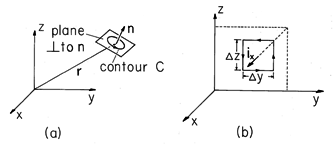If the integral laws of Ampère and Faraday, (1.4.1) and (1.6.1), are to be written in terms of one type of integral, it is necessary to have an operator such that the contour integrals are converted to surface integrals. This operator is called the curl.

The operator is identified by making the surface an incremental
one,  a. At the particular point r where the operator is to be
evaluated, pick a direction n and construct a plane normal to n
through the point r. In this plane, choose a contour C around
r that encloses the incremental area
a. At the particular point r where the operator is to be
evaluated, pick a direction n and construct a plane normal to n
through the point r. In this plane, choose a contour C around
r that encloses the incremental area  a. It follows from (1) that
a. It follows from (1) that

The shape of the contour C is arbitrary except that all its points are
assumed to approach the point r under study in the limit  a
a 0. Such an
arbitrary elemental surface with its unit normal n is illustrated
in Fig. 2.4.1a. The definition of the curl operator given by (2) is
independent of the coordinate system.
0. Such an
arbitrary elemental surface with its unit normal n is illustrated
in Fig. 2.4.1a. The definition of the curl operator given by (2) is
independent of the coordinate system.

To express (2) in Cartesian coordinates, consider the
incremental surface shown in Fig. 2.4.1b. The center of  a is at the
location (x,y,z), where the operator is to be evaluated. The contour
is composed of straight segments at y
a is at the
location (x,y,z), where the operator is to be evaluated. The contour
is composed of straight segments at y 
 y/2 and z
y/2 and z 
 z/2. To
first order in
z/2. To
first order in  y and
y and  z, it follows that the n = ix
component of (2) is
z, it follows that the n = ix
component of (2) is

Here the first two terms represent integrations along the vertical segments, first in the +z direction and then in the -z direction. Note that integration on this second leg results in a minus sign, because there, A is oppositely directed to ds.
In the limit, (3) becomes

The same procedure, applied to elemental areas having normals in the y and z directions, result in three "components" for the curl operator.

In fact, we should be able to select the surface for evaluating (2) as having a unit normal n in any arbitrary direction. For (5) to be a vector, its dot product with n must give the same result as obtained for the direct evaluation of (2). This is shown to be true in Appendix 2.
The result of cross-multiplying A by the del operator, defined by (2.1.6), is the curl operator. This is the reason for the alternate notation for the curl operator.

Thus, in Cartesian coordinates

The problems give the opportunity to derive expressions having similar forms in cylindrical and spherical coordinates. The results are summarized in Table I at the end of the text.

